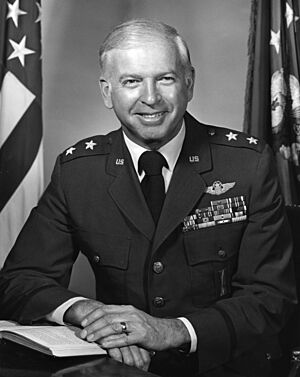H. M. Darmstandler facts for kids
Quick facts for kids
H. M. Darmstandler
|
|
|---|---|
 |
|
| Born | August 9, 1922 Indianapolis, Indiana |
| Died | February 21, 2012 (aged 89) San Diego, California |
| Allegiance | United States of America |
| Service/ |
United States Air Force |
| Years of service | 1942–1975 |
| Rank | Major general |
| Commands held | Special assistant to the chief of staff for B-1 Matters |
| Awards | Distinguished Service Medal, Legion of Merit with oak leaf cluster, Distinguished Flying Cross, Air Medal with two oak leaf clusters, Army Commendation Medal with oak leaf cluster, Air Force Outstanding Unit Award Ribbon, and the Republic of Korea Presidential Unit Citation Ribbon |
Harry Max Darmstandler (August 9, 1922 – February 21, 2012) was an American Air Force major general. He was a special assistant to the chief of staff for B-1 Matters at the U.S. Air Force Headquarters in Washington, D.C. In this important role, he helped coordinate all Air Force activities related to the B-1 bomber, a powerful aircraft.
Contents
Early Life and Education
Harry Darmstandler was born in Indianapolis, Indiana, on August 9, 1922. He finished high school at Arsenal Technical High School in 1940. Later, he earned a Bachelor of Science degree from the University of Omaha in 1964. He also received a Master of Science degree in international relations from The George Washington University in 1965.
Becoming an Air Force Pilot
Harry Darmstandler joined the aviation cadet program in May 1942 in Santa Ana, California. He trained hard and graduated as a pilot in February 1943. He became a second lieutenant at Luke Air Force Base in Arizona.
Flying in World War II
During World War II, Darmstandler first worked as an instructor pilot. He taught others how to fly for the Air Training Command. Later, he became the aircraft commander of a B-24 crew. His crew was part of the 456th Bombardment Group in Italy. He flew 21 combat missions during the war. After the war ended in Europe (V-E Day), he stayed in Italy until July 1945. During this time, he flew gasoline and oil into Trieste. In September 1945, he left active duty but remained in the Army Air Corps Reserve.
Supporting Key Operations
In November 1948, Darmstandler returned to active duty to help with the Berlin airlift. This was a huge effort to deliver supplies by air to West Berlin. He flew nearly 200 missions with the 29th Troop Carrier Squadron. After this, he joined the Air Proving Ground Command at Eglin Air Force Base, Florida.
Nuclear Tests and Korean War
In early 1951, he became a B-17 "director pilot" for Operation GREENHOUSE. These were nuclear tests held at Eniwetok Atoll. After the tests, he joined the 61st Troop Carrier Group in Japan. He flew cargo missions to support military operations in Korea. In November 1952, his group returned to the United States. They began flying C-124 Globemaster aircraft, and Darmstandler became the group's chief pilot.
Cold War Missions
In February 1954, Darmstandler moved to Donaldson Air Force Base, South Carolina. He worked as an operations and training inspector. During the winter of 1955–1956, he flew missions into frozen lakes in Northern Canada. This supported the installation of the Defense Early Warning (DEW) Line. This line of radar stations helped detect incoming attacks during the Cold War.
He also attended the Command and Staff School at the Naval War College. Later, he led a group of C-124 aircraft in Germany. During this time, he helped evacuate American citizens from Tel Aviv in 1956. He also helped airlift United Nations forces to the Suez during a conflict.
Important Leadership Roles
In July 1957, Darmstandler became an aide and pilot for the commandant of the Armed Forces Staff College. From September 1960, he worked for the commander in chief, Pacific, for three years.
Strategic Planning and Research
In July 1965, Darmstandler joined the Organization of the Joint Chiefs of Staff. He worked on planning for North America and later for the Pacific. During this time, he visited Vietnam. He analyzed how the Air Force, Army, and Marine Corps worked together.
In August 1968, he became a research fellow at the University of California, Los Angeles. In July 1969, he was assigned to Supreme Headquarters Allied Powers Europe. He became a special assistant and later an executive to the chief of staff there. In February 1972, he became the commander of the 12th Strategic Air Division at Davis-Monthan Air Force Base, Arizona.
Leading Strategic Air Command
In March 1973, Darmstandler became the assistant deputy chief of staff for plans for the Strategic Air Command (SAC). SAC was a major command responsible for nuclear deterrence. He became the deputy chief of staff for plans in September 1973. In this role, he helped create plans and programs for SAC. He also represented SAC to the Joint Chiefs of Staff.
Special Assistant for the B-1 Bomber
In July 1974, Darmstandler took on the role of special assistant to the chief of staff for B-1 Matters. This was his final major assignment before retirement.
Awards and Retirement
Major General Darmstandler received many military awards. These include the Distinguished Service Medal, the Legion of Merit with an oak leaf cluster, and the Distinguished Flying Cross. He also received the Air Medal with two oak leaf clusters, and the Army Commendation Medal with an oak leaf cluster. He was also given the Air Force Outstanding Unit Award Ribbon and the Republic of Korea Presidential Unit Citation Ribbon. He was a command pilot with over 7,000 flying hours.
He was promoted to major general on September 1, 1973. He retired from the Air Force on September 1, 1975. Harry Max Darmstandler passed away in 2012 at the age of 89.

